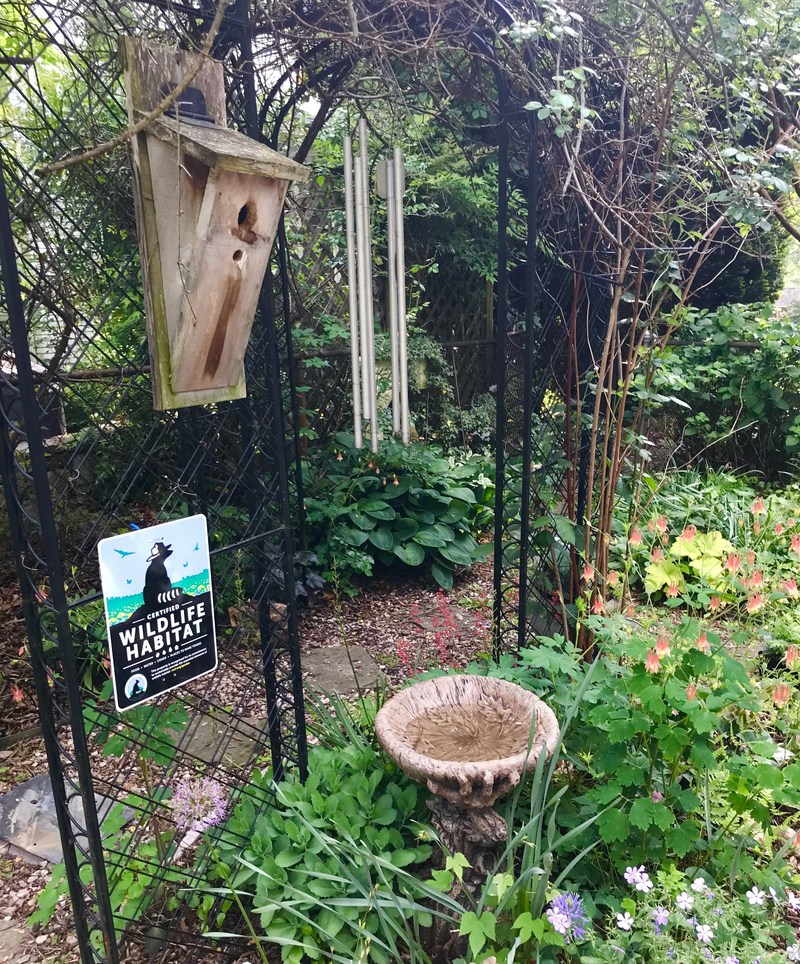RESTON, Va., May 15, 2018 /PRNewswire-USNewswire/ — With more than 7 million people participating across the country and 2.5 million acres of Certified Wildlife Habitat®, the National Wildlife Federation’s Garden for Wildlife movement is the nation’s longest-running and largest effort dedicated to helping wildlife locally. The initiative reconnects our neighborhoods, towns, and cities to our nation’s amazing wild spaces by encouraging Americans to plant native plants. From wildflowers to trees, there are small things we can do to provide natural sources of food, water, cover, and spaces to raise young in our backyards and communities. Anyone can support and protect the future of birds, bees, butterflies, and other amazing animals.

This Certified Wildlife Habitat® contains all 4 elements wildlife need – food, water, cover, and spaces to raise young.
This spring marks the 45th Anniversary of Garden for Wildlife, and in honor of that milestone, the National Wildlife Federation is inviting individuals, families and communities to design a garden space that will enhance the natural landscape and attract wildlife to their great outdoors.
Here are several easy and impactful ways to participate and start helping your local wildlife:
Create a Habitat for Your Local Wildlife. Think first of the birds, butterflies and bees that you can support in your garden habitat. Then select plants that provide the kinds of food they need, such as nectar, berries or seeds. Plant according to your region, local environment and conditions, from sunny deserts to shady woodlands. Use NWF’s “Plant Finder” to get a list of the plants native to your area that support wildlife.
Think Small. No yard, no problem! For those with small outdoors spaces, select pots and planters that will allow you to plant a selection of blooming pollinator-friendly native plants.
Plant for year-round diversity and beauty. Wildlife needs food, water, cover and places to raise young all year. Choose a variety of plants that bloom at different times of the year, from native wildflowers to shrubs that produce berries. Evergreens provide year-round cover. Think vertically, too. Incorporate existing large trees and then underplant with smaller trees and shrubs for cover and nesting places.
Plant in Groups. This will result in more color, textural impact and eye-catching patterns throughout the garden bed or landscape. This technique also draws the eye into the garden and the close plantings will prevent weeds and minimize the need for excess mulching. Clusters of blooming plants are more likely to attract butterflies, bees and hummingbirds.
Water sources. Adding bird baths or container water gardens help attract a variety of wildlife, from birds to tree frogs.
GOT NEWS? click here
Google News, Bing News, Yahoo News, 200+ publications
Certify Your Garden: Celebrate by certifying your garden with the National Wildlife Federation and proudly display a sign! Show why you have designed your yard intentionally to help wildlife and encourage others to do the same. Certifying also spreads the wildlife gardening message to your entire neighborhood.
To learn more, visit www.nwf.org/garden and follow us on Facebook and Twitter.
Contact: Anna Vecchio, National Wildlife Federation, [email protected], (503) 758-5521
![]() View original content with multimedia:http://www.prnewswire.com/news-releases/the-national-wildlife-federation-invites-americans-of-all-ages-to-transform-their-outdoor-spaces-into-a-wildlife-haven-with-garden-for-wildlife-tips-and-resources-300648911.html
View original content with multimedia:http://www.prnewswire.com/news-releases/the-national-wildlife-federation-invites-americans-of-all-ages-to-transform-their-outdoor-spaces-into-a-wildlife-haven-with-garden-for-wildlife-tips-and-resources-300648911.html
SOURCE National Wildlife Federation






